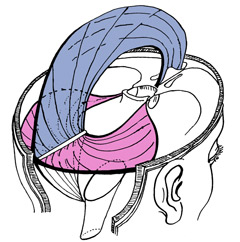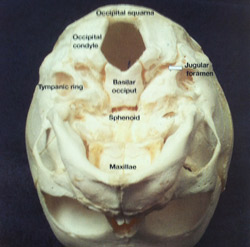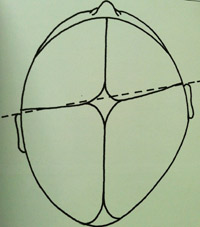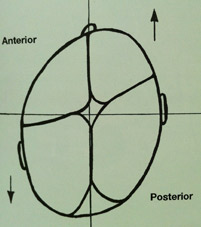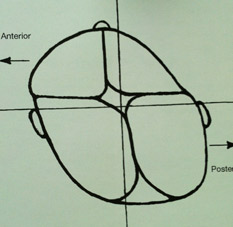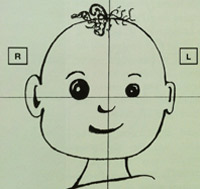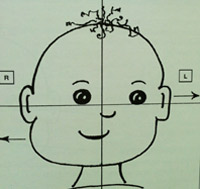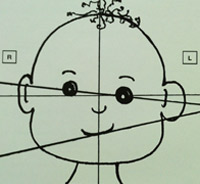Plagiocephaly at Apol Chiropractic
 The term plagiocephaly is derived from the Greek words meaning oblique head. There are 3 types of plagiocephaly. One is a result of a genetic disorder. The second is caused by fusion of one or more of the cranial sutures (joints between the head bones), it is termed cranial sutural synostosis. If this second type is suspected, the child is referred out for imaging. Surgical intervention maybe indicated. The third type is referred to as Non-synostotic deformational plagiocephaly. The third type is very correctable by using advanced cranial adjusting techniques and without the use of cranial bands or helmets. The amount of pressure used during infant cranial corrections is the amount of pressure you could apply to your eye and still feel comfortable.
The term plagiocephaly is derived from the Greek words meaning oblique head. There are 3 types of plagiocephaly. One is a result of a genetic disorder. The second is caused by fusion of one or more of the cranial sutures (joints between the head bones), it is termed cranial sutural synostosis. If this second type is suspected, the child is referred out for imaging. Surgical intervention maybe indicated. The third type is referred to as Non-synostotic deformational plagiocephaly. The third type is very correctable by using advanced cranial adjusting techniques and without the use of cranial bands or helmets. The amount of pressure used during infant cranial corrections is the amount of pressure you could apply to your eye and still feel comfortable.
What is Plagiocephaly (flat head syndrome)?
Plagiocephaly refers to a deformity of the skull in which one side appears more developed than the other. When looking down at the top of your baby’s head, is one ear further forward? Does one side of the forehead seem more forward? Does the back of the head seem flatter on one side or do both sides appear flat?

When looking at your baby’s face, does one eye seem smaller than the other? Is one ear higher than the other? Does one cheek seem fuller than the other?
Everyone has some asymmetry. But if you notice many of the characteristics noted above, you may want to discuss this with me.
Frequently Asked Questions
What causes plagiocephaly?
The visual distortions we see in the child’s head are a result of distortions in the component parts for the skull base (the bottom part of the head that sits on top of the neck). In the infant, the skull base is made of four individual pieces that fuse together as we age. Most often there is little or no evidence at birth. The distortions we see in the top bones of the skull are from the action of the dural membranes on the rapidly growing skull. The vault (top 2/3 of the head) is expressing asymmetries in the cranial base via the membrane system. 95% of skull distortions come from the cranial base.
Cranial Membranes
Cranial Base
The distortions of the skull base, usually from birth, are not evident until the skull starts growing. The shape of the head should normalize within 24 hours after birth. Anything longer than that is indication for cranial examination. The skull expands rapidly the first 2-3 months which is why many believe the cause to be repeated prolonged pressure placed on one side of the skull or there is preferential turning of the head to one side. The turning to one side is also a symptom of a distorted skull base. It is true that during treatment and after care should be taken to not aggravate the distortions. Reference Cranial illustrations use from “Pregnancy and Paediatrics a Chiropractic Approach” by Steve Williams
What are some early indications my child has a cranial problem?
Inability to turn head equally Suckles from one breast well and not the other Holds head tipped to the side and back Dislikes lying on back Poor sleep patterns Wakes screaming Suckles briefly, mouth doesn’t cover areola Weak suck
Distress while changing Excessively strong suck Mother complains of sore cracked nipples Coughs and chokes while feeding Infant colic Repetitive vomiting after feeding Nervous, crying, sleepless, tense baby Strabismus or crossed eyes
How do I know if my child is at risk?
A study done in 2002 of healthy newborns found the incidence of abnormal head shapes in single born infants to be 24% and in twins 56%. The risk factors they identified were assisted vaginal delivery, first child, prolonged labor, unusual birth position and male gender. They proposed that the head flattening they observed at birth was a precursor to plagiocephaly.
In Uterine
- Mothers health
- Pelvic distortions (rotated hips)
- Fetal positioning
Birth process
- Fetal positioning
- Prolonged labor
High intervention birth
- Forceps
- Vacuum extraction
- Caesarean section
What are the long term consequences if left uncorrected?
An important item for consideration during this decision process is the long-term consequences. When parents are making their treatment decision, one of the most frequently asked questions is “what effect does this have on my baby’s head?” While many doctors originally viewed plagiocephaly as only a cosmetic issue, many now realize that there are structural skull problems associated with plagiocephaly. Why would you want to limit the potential in your child’s future? Leaving plagiocephaly untreated can have that long-term implication. Remember: Choosing to treat plagiocephaly is most difficult for parents, but leaving it untreated can cause a lifetime of difficulty for both the parent and child. In 2000 a study was done on 250 patients with deformational positional plagiocephaly and they concluded – “infants with deformational plagiocephaly comprise a high risk group for developmental difficulties. 30-40% of these children needed extra help in school. They had problems with sensory motor skills like; tying laces, speaking, gross motor skills and fine motor skills” A 2012 study shows children with plagiocephaly have decreased language acquisition skills. (Understanding language) In 2011and 2012 studies demonstrated infants showed marked gross motor delays in infancy and as toddlers.
Less important cosmetic concerns would be:
- Glasses don’t sit straight on your child due to facial asymmetry?
- Sports helmets don’t fit your child’s head?
- Your daughter can’t wear ponytails or other hairstyles like the other girls?
- Your son’s “real” head shape is visible if he gets a buzz cut?
Schedule an Appointment
Call us today to have your baby checked for plagiocephaly.
CONTACT US »

Plagiocephaly Hoover AL | (205) 538-7410
 The term plagiocephaly is derived from the Greek words meaning oblique head. There are 3 types of plagiocephaly. One is a result of a genetic disorder. The second is caused by fusion of one or more of the cranial sutures (joints between the head bones), it is termed cranial sutural synostosis. If this second type is suspected, the child is referred out for imaging. Surgical intervention maybe indicated. The third type is referred to as Non-synostotic deformational plagiocephaly. The third type is very correctable by using advanced cranial adjusting techniques and without the use of cranial bands or helmets. The amount of pressure used during infant cranial corrections is the amount of pressure you could apply to your eye and still feel comfortable.
The term plagiocephaly is derived from the Greek words meaning oblique head. There are 3 types of plagiocephaly. One is a result of a genetic disorder. The second is caused by fusion of one or more of the cranial sutures (joints between the head bones), it is termed cranial sutural synostosis. If this second type is suspected, the child is referred out for imaging. Surgical intervention maybe indicated. The third type is referred to as Non-synostotic deformational plagiocephaly. The third type is very correctable by using advanced cranial adjusting techniques and without the use of cranial bands or helmets. The amount of pressure used during infant cranial corrections is the amount of pressure you could apply to your eye and still feel comfortable.![]()
